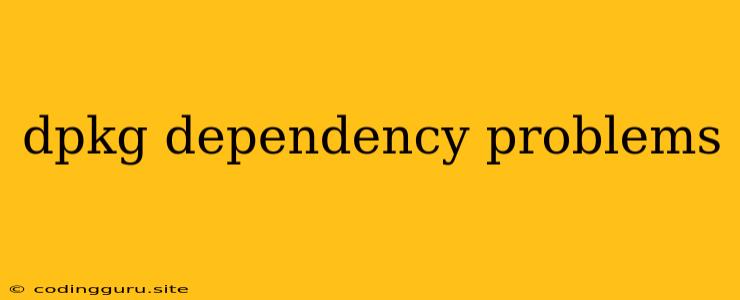Navigating the Depths of "dpkg dependency problems"
The dreaded "dpkg dependency problems" – a phrase that strikes fear into the hearts of many Linux users. It's an error message that can pop up when you're trying to install, remove, or upgrade packages using dpkg. The message typically indicates that the package you're trying to work with has dependencies that are not met. But fear not, this doesn't mean you're doomed to a life without your desired software. Let's delve into the reasons behind these problems and equip you with the tools to conquer them.
What are Dependencies and Why Do They Matter?
Imagine a complex machine – a car, for instance. The engine needs fuel, the wheels need tires, the brakes need pads. These parts, while distinct, are all interconnected and depend on each other for the car to function. Software packages work similarly. They often rely on other packages – libraries, tools, frameworks – to operate correctly. These are known as dependencies.
Dependency problems arise when the system detects missing or incompatible dependencies for the package you're attempting to install or manage. This can happen for several reasons:
- Missing Dependencies: The package you want needs certain packages that aren't installed on your system.
- Conflicting Dependencies: Two or more packages depend on different versions of the same package, creating a conflict.
- Circular Dependencies: A scenario where package A depends on package B, which depends on package C, which depends on package A, creating an endless loop.
- Broken Packages: A package on your system has been corrupted or damaged, rendering it unusable.
Decoding the Error Messages
When faced with a "dpkg dependency problems" message, the key to understanding the issue lies in the accompanying error messages. These messages usually provide crucial details about the specific dependencies that are causing the problem.
Common Error Messages:
- "Depends: ... but it is not installed." - This indicates a missing dependency. The package you're trying to install requires a specific package that's not present on your system.
- "Depends: ... but it is not available." - This signifies a missing dependency. The package you're trying to install requires a package that's not available in the package repositories.
- "Conflicts: ..." - This indicates a conflicting dependency. The package you're trying to install clashes with another package that has different dependencies.
- "Pre-Depends: ... but it is not installed." - This indicates a pre-dependency issue. The package requires certain other packages to be installed before it can be installed itself.
Troubleshooting Steps
Now that you've decoded the error messages, let's move onto the practical steps for resolving dpkg dependency problems:
-
Identify the Problematic Packages: Analyze the error messages carefully to pinpoint the package causing the dependency issues.
-
Install Missing Dependencies: If the error message points to a missing dependency, you can install it using the
aptpackage manager:sudo apt install -
Resolve Conflicting Dependencies: If the error message highlights conflicting dependencies, you might need to choose one package over the other. This can be done by carefully examining the packages in conflict and understanding which is more important to you. You can remove the conflicting package using
apt:sudo apt remove -
Update Your Package Lists: Sometimes, the issue arises because the package lists are outdated. Updating the lists can help by fetching the latest package information:
sudo apt update -
Try a "dpkg --configure -a" Fix: This command attempts to configure all packages that are in a half-installed state, which can sometimes resolve dependency problems.
sudo dpkg --configure -a -
Clean Up the Package Cache: Cleaning up the package cache using
aptcan sometimes help with dependency issues.sudo apt clean -
Use "apt-get install -f" to Fix Broken Packages: This command tries to automatically install the missing dependencies and repair broken packages:
sudo apt-get install -f -
Manually Remove Conflicting Packages: If
apt-get install -fdoesn't work, you might need to manually remove conflicting packages usingaptordpkg.sudo apt remove
Additional Tips
- Consult Online Resources: For complex or persistent dependency problems, search online for solutions specific to the error messages you're encountering. Websites like the Ubuntu Forums and Ask Ubuntu often have helpful discussions and troubleshooting guides.
- Use Package Managers: Stick to using
aptordpkgfor managing packages. Avoid downloading and installing packages directly from untrusted sources, as this can lead to dependency issues. - Consider a Fresh Install: In extreme cases, where dependency issues are pervasive, you might consider a fresh install of your Linux distribution.
Conclusion
Dependency problems can be frustrating, but by understanding the underlying causes and following the troubleshooting steps outlined above, you can often resolve them. Remember to be patient, consult online resources for assistance, and use the right tools. With a little effort and persistence, you can overcome these roadblocks and enjoy your desired software on your Linux system.
